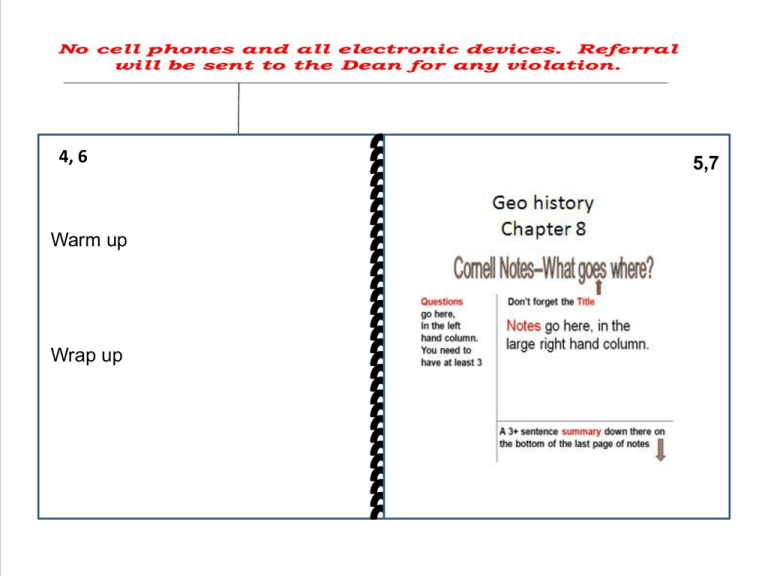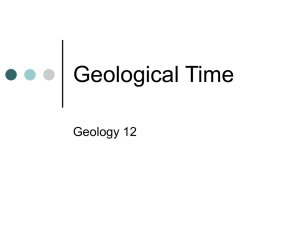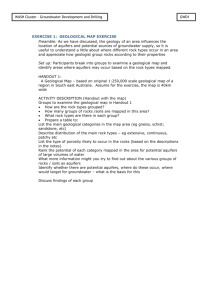Geological History (1): Strata
advertisement

4, 6 Warm up Wrap up 5,7 Geological History (1): Strata © Howard Falcon-Lang Youngest strata http://en.wikipedia.org/wiki/Nicolas_Steno Nicolas Steno (1638-1686) Oldest strata So far we’ve looked at early attempts to determine the age of the Earth, let’s now consider how other scientists were trying to work out its history. The term geological history refers to the sequence of historical events from the formation of the Earth to the present day. One of first people to try and understand the history of our planet was a Danish priest called Nicolas Steno (1638-1686). In 1669 he argued that sediment gradually built up on the sea floor as layers which are both laterally continuous and horizontal. The sediments at the bottom of the pile are the oldest and the sediments at the top are the youngest. Steno showed that in much the same way that the pages of a book are read from left to right, the history of the Earth must be read from bottom to top in a layered succession of rocks. Background note: Steno’s insight that sediments accumulate in continuous horizontal layers is known as the Principle of Horizontality and the Principle of Lateral Continuity. His insight that the oldest sediments are at the bottom and the youngest at the top is known as the Principle of Superposition. These three principles are fundamental to understanding the order that events occurred through Geological Time. geological history sequence of historical events from the formation of the Earth to the present day strata Rock layer Principle of Horizontality and Principle of Lateral Continuity sediments accumulate in continuous horizontal layers Principle of oldest sediments are at the Superposition. bottom and the youngest at the top Geological History (2): Neptunism http://en.wikipedia.org/wiki/Image:Abraham_ Gottlob_Werner.jpg • Werner argued all rocks had been deposited in a worldwide ocean (think Noah’s Flood) • Geologists could figure out the order in which rocks formed • Divided geological record into four main divisions Abraham Werner (1749-1817) Granite © Howard Falcon-Lang A century later, Abraham Werner (1749-1817), a mining engineer from Saxony, started to apply some of Steno’s principles to understand the history of the Earth. He thought that all the Earth’s rocks had been deposited from a worldwide ocean (think Noah’s Flood in the Bible). This idea was later dubbed ‘Neptunism’ after the Roman god of the sea (Neptune). Neptunism Earth’s rocks had been deposited from a worldwide ocean (think Noah’s Flood in the Bible). Geological History (3): Gaps Copyright © Marli Miller, University of Oregon http://upload.wikimedia.org/wikipedia/ commons/c/c6/James_Hutton.jpg Siccar Point • Hutton’s unconformity showed that there were big gaps in the geological record James Hutton (1726-1797) Hot on the heels of Werner came another influential geologist called James Hutton (1726-1797). In the late eighteenth century, Hutton realized that there were ‘big gaps’ in the geological record of time. At several places like Siccar Point in Berwickshire, Scotland, Hutton’s noticed beds of layered rocks that stood on their end overlain by other layered rocks that dipped away at a shallow angle. Hutton was quick to realize what this meant. In the real world, sediment is not deposited continuously. Rather through convulsions of the Earth’s crust, sediments laid down as horizontal layers in the sea might be pushed up to form mountains. The layers might then be tilted at an angle and partly eroded away before new horizontal layers accumulated on top. Hutton’s name for this kind of angular contact between two sets of sedimentary layers was an unconformity. In the time between the formation of the lower and upper layers of rocks, a mountain had been born and eroded down. This would have taken tens of millions of years. Therefore the unconformity represented a massive time gap in the geological record. Hutton referred to this phenomenon as ‘the abyss of time’. James Hutton (1726–1797) unconformity “father of modern geology” Believed Earth to be ever changing and very old angular contact between two sets of sedimentary layers Unconformities Movements in the Earth’s crust can lift up rock layer that were buried and expose them to erosion. If layers of new sedimentary rock are laid down on this eroded surfaces, an unconformity forms. Unconformities are boundaries between old rock and new rock and they indicate an interruption in the rock record. The old rock may be igneous, metamorphic or sedimentary. The new rock is always sedimentary. According to the Law of Superposition, all rocks beneath the unconformity are older than the rocks above it. When rock layers are tilted or Angular nonconformity folded, then eroded and new sedimentary rock is laid on top of the eroded surface. Disconformity When sedimentary rock is eroded and new sedimentary rock is laid over top. When igneous or metamorphic Nonconformity rock is exposed and eroded and new sedimentary rock is laid over top. HACHURES INDICATE METAMORPHISM Pg. 9 Construct the spider diagram. At the end of each leg, there are 2 lines(toes). At the end of one line/toe write the definition for the concept and at the end of the second line/toe, draw a picture illustrating the concept. Definition Picture Types of unconformities 6 Warm up Wrap up 7 8 Warm up Wrap up 9 Geological History (4): Maps http://en.wikipedia.org/wiki/Image: Geological_map_of_Great_Britain.jpg http://en.wikipedia.org/wiki/Image:Smith_fossils2.jpg http://en.wikipedia.org/wiki/Image: William_Smith.g.jpg Some of Smith’s fossils William Smith (1769-1839) The Map that changed the World At the turn of the nineteenth century, ‘maps’ followed ‘gaps’ in the discovery of geological history. In Britain railways and canals were being constructed all over the place. More than ever before, rocks were being exposed all over the country. William Smith (1769-1839) was a surveyor who saw more than his fair share of rocks. He realized that sequences of different rocks occurred in the same order in different places. To be sure that a rock type in one place was the same as a rock type in another place, he compared the fossils that they contained. Soon he started to draw maps of where the different rock strata occurred and by 1815 he had produced a complete geological map of Britain. Building on the insights of Steno, Werner and Hutton, William Smith’s map showed the relative order in which the rocks of Britain formed and whether there were any big time gaps within the succession. For the first time, the geological history of a whole country was known. Geological History (5): Fossils en.wikipedia.org/wiki/Image:Georges_Cuvier.jpg en.wikipedia.org/wiki/Image:Charles_Lyell.jpg Cuvier Georges Cuvier (1769-1832) Charles Lyell (1797-1875) • Cuvier showed that some animals had gone extinct • Lyell used the proportion of living fossils to divide up geological time • Older rocks contained more extinct types than younger rocks As we have just seen, William Smith used fossils to check that the age of rocks in one area was the same at the rocks in another. But why should rocks of different ages contain the remains of different life forms? It fell to two other scientists, Georges Cuvier (1769-1832) and Charles Lyell (1797-1875) to answer this question and in doing so discover the concept of extinction. Cuvier was a French naturalist. In 1796 he studied remains of fossil and living elephants. He convincingly showed that animals like the woolly mammoth had gone extinct. This was a pretty radical idea because up to that point people thought extinction was impossible. After all, if God’s creation was perfect why would He let species like the mammoth die out? A little later in 1828, Lyell studied fossil seashells in Tertiary rocks in France. He showed that the oldest rocks contained mostly extinct shells while the youngest rocks contained shells similar to those living today. He divided up these Tertiary deposits into three epochs which he named, from oldest to youngest, the Eocene, Miocene, and Pliocene. At last here was an explanation as to why the rocks of different time periods contained distinctively different types of life forms fossils preserved remains or traces of animals Geological History (6): Stratigraphy Sedgewick Murchison commons.wikimedia.org/wiki/Image :Adam_Sedgwick.jpg en.wikipedia.org/wiki/Image:Roderick _Murchison.jpg en.wikipedia.org/wiki/Image:Geological_map_of_Great_Britain.jpg A tug-of-war as rocks got sorted into geological periods in the new science of stratigraphy One famous argument was between Adam Sedgewick (1785-1873) and Roderick Murchison (1792-1871). Both these men mapped the rocks in Wales, which were thought at that time to be the oldest rocks that contained fossils. Both wanted to be the first to name this ancient geological period. Sedgewick proposed the name Cambrian for the the geological period represented by his rocks in Central Wales. Murchison proposed the name Silurian for the the geological period represented by his rocks in North Wales. As the Cambrian and Silurian strata overlapped, Murchison wanted all of Sedgewick’s Cambrian to be included in his Silurian. Based on the fossils they contained, Murchison didn’t think there was much age difference between the two time periods. Murchison and Sedgewick had a real tug-of-war over the rocks of Wales and afterwards didn’t speak to each other for years to come. Eventually, in 1879, Charles Lapworth (1842-1920) sorted out the Welsh problem. He carried on using the names, Cambrian and Silurian, but re-named the overlapping beds in the middle as the Ordovician. Hence the oldest rocks in Britain that contain ‘visible fossils’ comprise three geological periods which are, from oldest to youngest, the Cambrian, Ordovician, and Silurian. stratigraphy The science of mapping rocks and working out their age relative to one another Geological History (7): Periods en.wikipedia.org/wiki/Geologic_time_scale Carboniferous Triassic Cambrian Ordovician Silurian Permian Devonian Jurassic Quaternary Cretaceous Tertiary It wasn’t just in Wales that disputes raged about the naming and relative age of different rock types. Throughout the nineteenth century, geologists all over Europe were describing the geological record, eager to be the first to name the different geological periods. The Devonian Period was named after rocks in Devon that were a little younger than Sedgewick’s Silurian. The Carboniferous Period was named after the coal-rich rocks in Yorkshire. The Jurassic Period was named after the rocks of the Jura Mountains of Switzerland, and so on. Geological History (8): The Column http://en.wikipedia.org/wiki/Geologic_time_scale Geological Time: Eons, Eras, Periods and Epochs Geological History (9): Example en.wikipedia.org/wikiImage:Palais_de_la_Decouvert e_Tyrannosaurus_rex_p1050042.jpg http://en.wikipedia.org/wiki/Image:KT_boundary_054.jpg Impact http://en.wikipedia.org/wiki/Image:Impact _event.jpg Paleogene Extinction Cretaceous en.wikipedia.org/wiki/Image:Tyrannosaurus_BW.jpg Radiometric dating (1): Discovery http://en.wikipedia.org/wiki/Image: Henri_Becquerel.jpg • In 1896, Discovery of radioactivity paved the way for the precise dating of events in the geological record Henri Becquerel (1852-1908) Radiometric dating (2): Decay en.wikipedia.org/wiki/Image:Alpha_Decay.svg • Radioactive ‘parent isotopes’ spontaneously emit protons and neutrons and decay into ‘daughter isotopes’ • E.g., Uranium-238 decays into Lead-206 Radiometric dating (3): Half life Half life: 0 Exponential Half life: 1 Linear Half life: 2 • The rate of decay from parent to daughter isotope depends on its half life. The half life is the amount of time needed for half the parent isotope to decay to daughter isotope Radiometric dating (4): Clocks Decay series 40K Half life to 40Ar 147Sm to 143Nd 1250 Ma Geological timescales 1060 Ma 235U to 207Pb 704 Ma 238U to 206Pb 4468 Ma 14C to 14N 5370 years Archaeology • Different radioactive isotopes have different half lives • Isotopes with long half lives are useful for dating old rocks. It is important to use the right tool for the right job Radiometric dating (5): Pioneers • Rutherford figured out a technique to date the age of rocks in 1904 • Holmes developed this kind of ‘radiometric dating’ still further. • In 1913 Holmes dated en.wikipedia.org/wiki/Image: en.wikipedia.org/wiki/Image: A Holmes.jpg Ernest_Rutherford2.jpg some rocks from Ceylon Ernest Rutherford Arthur Holmes to 1600 million years (1890-1965) (1871-1937) Radiometric dating (6): Oldest Rock Zircon mineral en.wikipedia.org/wiki/Image:Zircon_microscope.jpg © NASA • Oldest rocks on Earth are the Acasta Gniess of northern Canada • 4030 million years old Acasta Gneiss Radiometric dating (7): Oldest Grain www.geology.wisc.edu/zircon/Earliest%20Piece/Images/2a-team.jpg • Ancient mineral grain found at Jack Hills, Australia • Mineral grain eroded from first crust and then deposited in a new rock © NASA • Dates the Earth’s first crust to around 4404 million years 4404 Ma zircon grain www.geology.wisc.edu/zircon/Earliest%20Piece/Images/5.jpg Radiometric dating (8): Meteorites http://upload.wikimedia.org/wikipedia/commons/0/00/Crab_Nebula.jpg Canyon Diablo meteorite en.wikipedia.org/wiki/Image:Canyon-diablo-meteorite.jpg Crab Nebula • Radiometric age of meteorites date the formation of the Solar System and Earth (4550 million years old) Radiometric Dating (9): History http://en.wikipedia.org/wiki/Geologic_time_scale © World Health Org. first life en.wikipedia.org/wiki/Image:Eopraptor_sketch5.png dinosaurs © NASA origin of Earth first complex cells humans Geological Time © NASA







